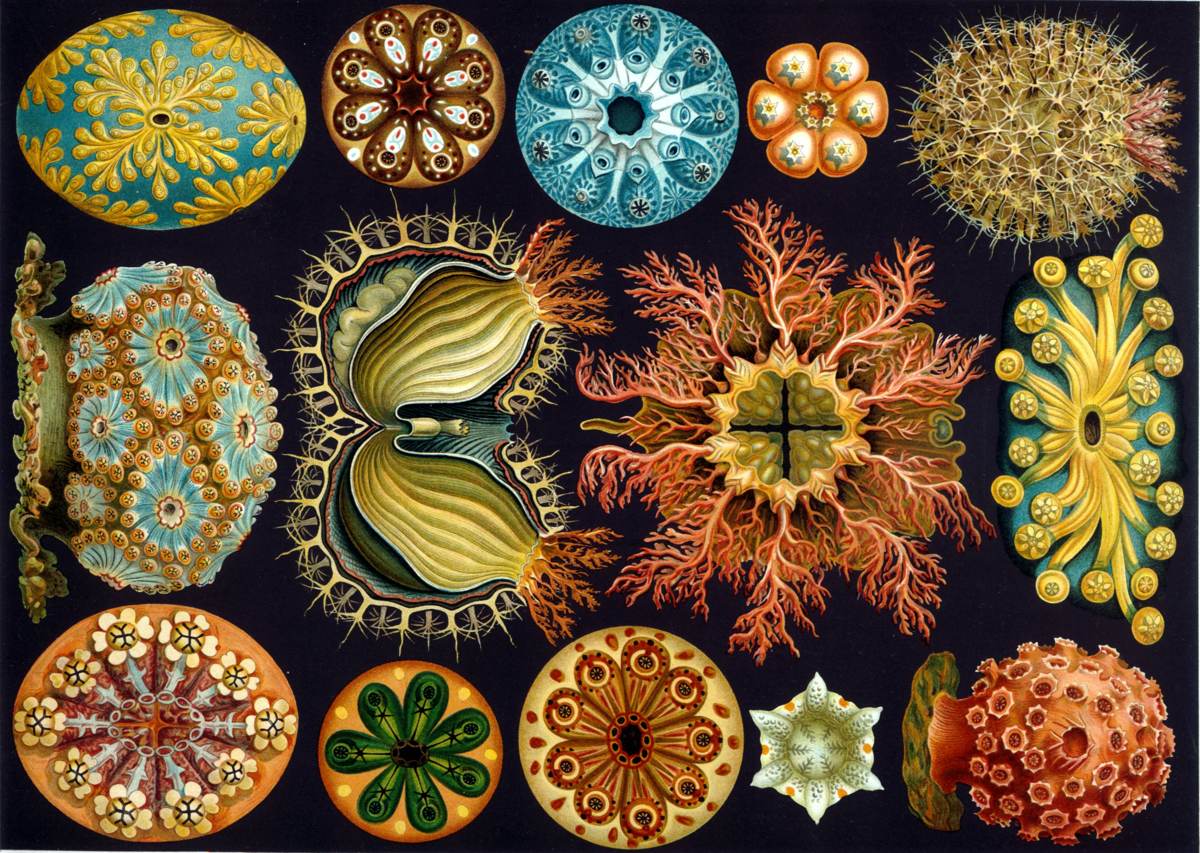Science
can now understand far better one of the previously intractable
problems in evolutionary biology: the origin of novelty.
by Peter Ward and Joe Kirschvink
A traditional mainstay of the biological sciences, mainly
evolutionary development, has undergone a renaissance so important that
it can almost be considered a new field as well. Its practitioners now
call it evo-devo, and breakthroughs in this field have had a lot to say
about the Cambrian explosion in the last decade. One of the greatest of
evo-devo practitioners, Sean Carroll, has given us an exquisite tour of
this newly revivified area of science in his 2005 book
Endless Forms Most Beautiful.
If there is any single theme in this work, it is that science can now
understand far better one of the previously intractable problems in
evolutionary biology: the origin of novelty. How evolutionary innovation
took place over relatively short periods of time just could not be
explained by traditional Darwinian concepts of evolution. The radical
breakthroughs—be it the appearance of wings, legs for land, segmentation
in arthropods, or even large size, the hallmark of the Cambrian
explosion—could not stand up to stories about many and sudden mutations
all working in concert to somehow radically change an organism. Evo-devo
now seems to have solved this, and in his book, Carroll lists four
aspects that combined can explain sudden evolutionary innovation that
nicely encapsulates the new way of explaining how radical changes did
take place.
The first “secret to innovation,” as Carroll puts it, is to “work
with what is already present.” The concept that “nature works as a
tinkerer” is central to this. Innovation does not always need a new set
of equipment to build, or even a new set of tools. What is already
present is the easiest route. Second and third are two aspects
understood by Darwin himself: multifunctionality and redundancy.
Multifunctionality first is using an already present morphology
or physiology to take over some second function in addition to that for
which it was first evolved. Redundancy, on the other hand, is when some
structure is composed of several parts that complete some function. If
one of these can be then co-opted for some new kind of job, while the
remaining parts are still able to function as before, there is in place a
clear path for innovation that is far easier to use than the total de
novo formation of some entirely novel morphology from scratch.
Cephalopod swimming and respiration are like this. Cephalopods routinely
pump huge quantities of water over their gills, and like many
invertebrates used separated “tubes” or designated channels for water
coming in and water being expelled, to ensure that oxygen-rich water is
not rebreathed. But with minor morphological “tinkering” with this
excurrent tube, a powerful new means of locomotion came about. Breathing
and moving could now take place using the same amount of energy by
utilizing the same volume of water for respiration and movement.
The final secret is modularity. Animals built of segments, such
as the arthropods, and to a lesser extent we vertebrates, are already
composed of modules. The limbs branching off arthropod segments have
been amazingly modified into feeding, mating, and locomotion, as well as
many other functions. Arthropods are like a Swiss army knife, with each
segment bearing limbs evolved to do a very specific function. The same
is true in vertebrates with our digits, which have been modified to
tasks as varied as walking on land to swimming to flying in the air. Not
bad for some primitive fingers and toes! Where does the evo-devo come
into play? It turns out that these morphologies are the soft putty for
morphological change because they are underlain by systems of genetic
“switches,” geographically located on the developing embryo in the same
positions as the various limbs are found in the arthropod—or vertebrate.
Switches are the key here; they tell various parts of the body
when and where to grow. One of the great discoveries is that the exact
sequence of different body regions on an arthropod from its head to
midregion to abdomen are lined up first on chromosomes in the same
geographic pattern, and then on the developing embryo itself. Much of
this is done by the crown jewels of the evo-devo kingdom: the Hox genes,
and their differently named but equivalents in other taxonomic groups.
The many new discoveries of evo-devo have certainly been brought
to bear on the many questions to be solved about that central mystery in
the history of life, the Cambrian explosion, and the most important
understandings of all: the timing of when and how the various animal
phyla and thus separate body plans that we see today originated.
There have long been two schools of thought. The first is that
the fossil record gives us a true picture of when the great
differentiation of animals actually took place—phyletic divergence
somewhere about 550 to perhaps 600 million years ago. But the second
line of evidence comes from comparing genes of extant members of the
ancient phyla, and using the concept of the “molecular clock,” mentioned
earlier. At issue is when the most fundamental divisions in the animal
kingdom take place—the split between an aggregate of phyla called
protostomes and those called deuterostomes. These two groups are
separated by fundamental anatomical and developmental differences in
embryos.
The protostomes are composed of the arthropods, mollusks, and
annelids among others, and they are characterized by embryos that as
they develop and grow following fertilization form a mouth out of a
central opening in the growing larva called the blastopore. In
deuterostomes (echinoderms, us vertebrates, and a number of minor
phyla), the mouth and the blastopore remain separate. There is a third
group, the very primitive phyla that split off from the main stem of
animal evolution prior to the great protostome-deuterostomes split:
these include the Cnidaria, sponges, and other jellyfish-like minor
phyla.
The first to appear were the simplest forms, the cnidarians and
sponges, which appear to be represented, as we have seen, in the
Ediacaran assemblages of as much as 570 million years ago, the time
interval before the Cambrian period (which began at 542 million years
ago). But recognizable protostomes and deuterostomes are not seen until a
short interval into the Cambrian period itself.
If the protostomes and deuterostomes split, what was the last
animal before that split like? Many lines of evidence indicate that this
creature was bilaterally symmetrical and was capable of locomotion.
Many who ponder this time and its animals imagine this last common
ancestor of both the protostomes and deuterostomes as a small
featureless worm, perhaps like the modern-day
Planaria, or the
tiny and extant nematodes. But one of the great new discoveries is that
this last member of the as yet undivided stock already had a genetic
tool kit allowing it to begin some radical new engineering—and had such a
tool kit for at least 50 million years before it was put into use! This
worm would have had a mouth at front, anus at the rear, and a long
tubelike digestive system in between. It may have had stubby projections
sticking out of its side, perhaps for sensory information (touch and
chemical sensing?). But the point is that all of this was set up in such
a way that rapid transformation could—and did—take place. This is new.
All the tools and features necessary for the Cambrian explosion sat
around for 50 million years.
As noted above, the base of the Cambrian is dated now at 542
million years ago. The base of the period has been defined as the place
in rock where the first identifiable locomotion marks are found in
strata—a certain kind of trace fossil showing that animals, moving
animals, were present and could make vertical burrows in the mud. Yet
for the next 15 million years, there seems to have been little formation
of new body plans at all—or at least that we can find evidence of in
the fossil record. The first real indication that a great
diversification was taking place comes from the spectacular fossil beds
only recently discovered in Chengjiang, China, dated as 520 to 525
million years in age and mentioned above. It is an older version of the
Burgess Shale in having common preservation of soft parts.
Both the Chengjiang and Burgess Shale faunas are dominated by
arthropods — lots and lots of different kinds of arthropods. They soon
became the most diverse animals on Earth — and have stayed that way ever
since. There are some estimates that in our modern day, there may be as
many as 30 million separate species of beetles alone!
Evo-devo tells us why. Of all the body plans, none can be so
easily, quickly, and radically changed as arthropods. The reasons are
just those listed above by Carroll: arthropods have modular parts, they
have redundant morphologies that can be co-opted for new functions, and
they have a series of Hox genes that allow ready transformation of
specific regions in the overall body plan of segments throughout.
The old view has been that new animals mean that there must have
been new genes coming into existence. There is sound logic in this.
Surely a primitive sponge or jellyfish would have fewer genes than the
more complex arthropods: it was argued that the common ancestor of all
arthropod groups somehow added new genes—new Hox genes, as these are
those that are the “switches” that tell the various parts of a body how
to form and when. But such is not the case. Carroll and others showed
that the last common ancestor of the arthropods did not evolve new
genes; it already had them, and that the subsequent and amazing
diversification of so many kinds of arthropods was done with existing
genes. As Carroll put it: “The evolution of forms is not so much about
what genes you have, but about how you used them.”
Ten different Hox genes were all that were necessary to utterly
change and diversify the arthropods. Their secret was discovered by
comparing the distribution of the product of Hox genes—proteins that are
specific to a particular Hox gene—and where these proteins can be found
on a developing embryo. The old idea that some gene or genes of an
arthropod coded for the construction of a leg is false. The Hox genes
make proteins. These proteins then become the means of starting and
stopping the growth of particular regions of a developing embryo. Some
of these proteins are concerned with making specific kinds of
appendages. If those Hox gene proteins are somehow moved to different
geographic regions on the developing embryo, the product that is
produced will move as well. In this way a leg that was formerly in one
part of the body might suddenly be found in a totally new place—if,
however, the Hox gene protein was somehow moved to the corresponding
place on the embryo long before the leg was formed. Innovation came from
shifting the geographic places or “zones” on an embryo that a specific
Hox gene protein could be found in.
Shifting the Hox gene zones in arthropod embryos resulted in the
many different kinds of arthropods that we see. There are thousands,
perhaps millions of different kinds of arthropod morphologies—and all of
this was evolved using the same tool kit of ten genes. Arthropods are
nothing if not body plans with repetitive parts. The specialization of
these parts requires that each falls into a separate Hox gene zone.
























